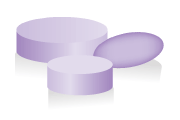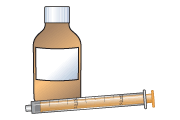Metronidazole for bacterial infections
This leaflet is for parents and carers about how to use this medicine in children. Our information may differ from that provided by the manufacturers, because their information usually relates to adults. Read this leaflet carefully. Keep it somewhere safe so that you can read it again.
If your child has ever had a reaction to any antibiotic, tell your doctor before giving Metronidazole .
Name of medicine
Metronidazole
Brand names: Flagyl, Flagyl S, Norzol
Why is it important for my child to take Metronidazole ?
It is important that your child takes this medicine in the way that your doctor has told you to so that it kills the harmful bacteria and gets rid of their infection.
What is Metronidazole available as?
- Tablets: 200 mg, 400 mg
- Liquid medicine (suspension): 200 mg in 5 mL
When should I give Metronidazole
Metronidazole is usually given three times a day. This should be in the morning, early afternoon and at bedtime. Ideally, these times are at least 6 hours apart, for example 8 am, 2 pm and 8 pm.
Give the medicine at about the same time(s) each day so that this becomes part of your child’s daily routine, which will help you to remember.
How much should I give?
Your doctor will work out the amount of Metronidazole (the dose) that is right for your child. The dose will be shown on the medicine label.
It is important that you follow your doctor’s instructions about how much to give.
How should I give Metronidazole ?

Tablets
- Tablets should be swallowed with a glass of water, squash or juice. Your child should not chew the tablet.

Liquid medicine
- Shake the medicine well.
- Measure out the right amount using an oral syringe or a medicine spoon. You can get these from your pharmacist. Do not use a kitchen teaspoon as it will not give the right amount.
When should the medicine start working?
Your child should start to get better after taking the medicine for 2-3 days. It is important that they take the whole course of the medicine that has been prescribed. Do not stop early.
What if my child is sick (vomits)?
- If your child is sick less than 30 minutes after having a dose of Metronidazole , give them the same dose again.
- If your child is sick more than 30 minutes after having a dose of Metronidazole , do not give them another dose. Wait until the next normal dose.
If your child is sick again, seek advice from your family doctor, nurse, pharmacist, or hospital. They will decide what to do based on your child’s condition and the specific medicine involved.
What if I forget to give it?
If you miss a dose, wait until the next normal dose. Do not give the missed dose.
What if I give too much?
You are unlikely to cause harm if you give an extra dose of Metronidazole by mistake. If you are concerned that you may have given too much, contact your doctor or local NHS services (details at end of leaflet). Have the medicine or packaging with you if you telephone for advice.
Are there any possible side effects?
We use medicines to make our children better, but sometimes they have other effects that we don’t want (side-effects).
Side effects you must do something about
If your child gets bad stomach pain that reaches through to their back, contact your doctor or take your child to hospital straight away as they may have a problem with their pancreas.
If your child is very tired, or has unusual bruising or bleeding, contact your doctor as there may be a problem with their blood.
If your child gets a yellowish tinge to the skin or whites of the eyes, contact your doctor straight away, as there may be a problem with your child’s liver.
Other side-effects you need to know about
Your child may have diarrhoea, stomach pains, feel sick or be sick (vomit) when they first start to take metronidazole. See the box on antibiotics below for advice on what to do.
Contact your doctor if your child has diarrhoea that goes on for more than 4 days or if it is severe and watery, or contains blood.
Your child’s tongue may feel furry to them. Sucking or chewing a sweet may help. Your child may also get mouth ulcers. If this occurs contact your doctor.
Your child may experience a metallic or bitter taste in their mouth. Eating citrus fruits (e.g. oranges) or sipping water may help.
Your child may feel less hungry (lose their appetite). Encourage them to eat small meals often.
There may sometimes be other side effects that are not listed above. If you notice anything unusual and are concerned, contact your doctor. You can report any suspected side effects to a UK safety scheme at mhra.gov.uk/yellowcard
Can other medicines be given at the same time as Metronidazole ?
- You can give your child medicines that contain paracetamol or ibuprofen, unless your doctor has told you not to.
- Metronidazole should not be taken with some medicines. Tell your doctor or pharmacist about any other medicines your child is taking before giving Metronidazole .
Check with your doctor or pharmacist before giving any other medicines to your child. This includes herbal and complementary medicines.
Is there anything else I need to know about this medicine?
If your child has ever had a reaction to any antibiotic, tell your doctor or pharmacist before giving Metronidazole .
- Teenagers should be aware that they must not drink alcohol while taking Metronidazole , and for 48 hours after finishing the course, as it is likely to make them unwell. They are likely to feel sick (nausea) or be sick (vomit), have stomach pains, hot flushes, headache and a fast or uneven heartbeat.
General advice about medicines
If you think someone else may have taken the medicine by accident, contact your doctor straight away.
General advice about antibiotics
- It is vital that your child completes the course of antibiotic. This means that they must take the medicine for the number of days that the doctor has told you, or until all the tablets or capsules have been taken.
- Your child will probably start to feel better soon after starting to take the antibiotic. However, it takes a few days for the antibiotic to kill all the bacteria.
- If you stop giving the antibiotic too soon, the bacteria that are left will start to multiply again, and may cause another infection.
- There is also a risk that these bacteria will be ‘resistant’ to the first antibiotic. This means that it might not work next time, and your child might need a different antibiotic, which might not work as well or cause more side effects.
- Children are sometimes sick (vomit) or get diarrhoea when taking antibiotics. Encourage them to drink water to replace the fluid they have lost. You can also buy oral rehydration fluid from your pharmacist.
- Do not give your child any medicine to stop the diarrhoea unless your doctor has told you to.
- Try to give the antibiotic at about the same time(s) each day, to help you remember, and to make sure that there is the right amount of medicine in your child’s body to kill the bacteria.
- Only give this medicine to your child for their current infection.
- Never save medicine for future illnesses. Give old or unused antibiotics to your pharmacist to dispose of.
- Only give the antibiotic to the child it was prescribed for. Never give it to anyone else, even if their condition appears to be the same, as it could do harm.
- Antibiotics only kill bacteria; they do not kill viruses. This means that they do not work against colds, sore throats, flu or other infections that are caused by viruses. Your doctor will not prescribe antibiotics for these illnesses.
If you think someone else may have taken the medicine by accident, contact your doctor for advice.
Where should I keep this medicine?
- Keep the medicine in a cupboard, away from heat and direct sunlight.
- It does not need to be kept in the fridge.
- Make sure that children cannot see or reach the medicine.
- Keep the medicine in the container it came in.
Who to contact for more information?
Your child’s doctor, pharmacist or nurse will be able to give you more information about Metronidazole and about other medicines used to treat infections.
England: NHS 111
Tel 111
www.nhs.ukScotland: NHS 24
Tel 111
www.nhs24.scotNorthern Ireland: NI Direct
Wales: NHS 111 Wales
Tel 111
www.111.wales.nhs.ukCopyright disclaimer
Version [1]. © NPPG, RCPCH and WellChild, all rights reserved. Review by May 2015.
The primary source for the information in this leaflet is the British National Formulary for Children. For details on any other sources used for this leaflet, please contact us through our website, www.medicinesforchildren.org.uk.
We take great care to make sure that the information in this leaflet is correct and up-to-date. However, medicines can be used in different ways for different patients. It is important that you ask the advice of your doctor or pharmacist if you are not sure about something. This leaflet is about the use of these medicines in the UK, and may not apply to other countries. The Royal College of Paediatrics and Child Health (RCPCH), the Neonatal and Paediatric Pharmacists Group (NPPG), WellChild and the contributors and editors cannot be held responsible for the accuracy of information, omissions of information, or any actions that may be taken as a consequence of reading this leaflet.
